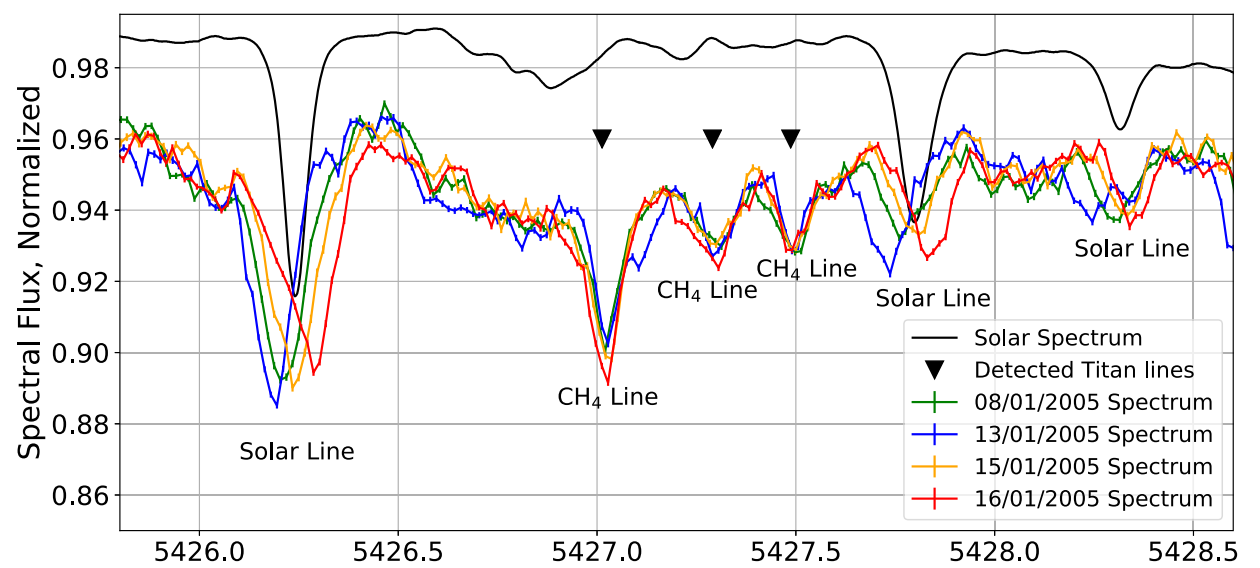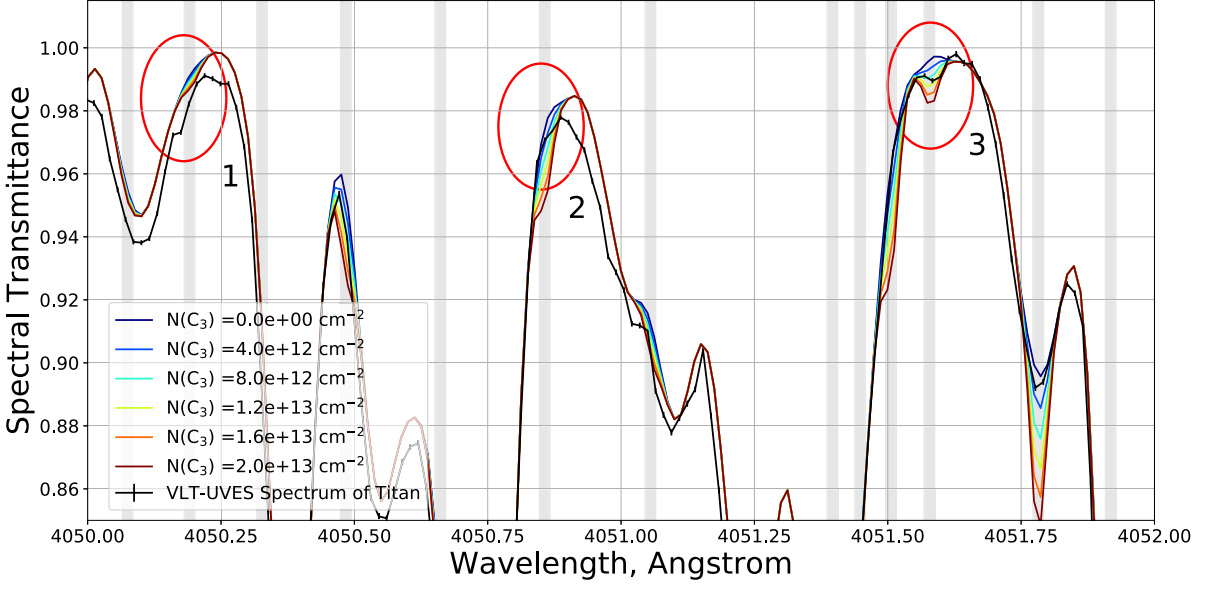A study of very high resolution visible spectra of Titan - Caracterization of visible CH4 bands and the search for C3
- 1Instituto de Astrofísica e Ciências do Espaço, Observatório Astronómico de Lisboa, Ed. Leste, Tapada da Ajuda, 1349-018 Lisbon, Portugal
- 2Faculdade de Ciências, Universidade de Lisboa, Portugal
- 3Centro de Química Estrutural, Institute of Molecular Sciences and Department of Chemical Engineering, Instituto Superior Técnico, Universidade de Lisboa, Portugal
- 4LESIA, Observatoire de Paris, PSL Research University, CNRS, Sorbonne Universités, Université de Paris, France
- 5Institut des Sciences Moléculaires (ISM), CNRS, Univ. Bordeaux, France
- 6Laboratoire d’Astrophysique de Bordeaux, Univ. Bordeaux, CNRS, France
The atmosphere of Titan is a unique natural laboratory for the study of atmospheric evolution and photochemistry akin to that of the primitive Earth (1), with a wide array of complex molecules discovered through infrared and sub-mm spectroscopy (2) (3). Here, we present the results of the exploration of original, ground-based, very high-resolution visible spectra of Titan, obtained with VLT-UVES (4), shedding light on a poorly explored part of Titan’s spectrum – containing understudied visible methane absorption bands – with high-resolution ground-based spectroscopy. Here we also present a new, Doppler-based line detection method for backscattered planetary atmosphere spectra: By comparing VLT-UVES spectra of Titan obtained in distinct observation nights (with distinct radial velocities between Titan and the Sun) it was possible to automatically distinguish absorption lines originated on Titan’s atmosphere from backscattered solar absorption lines. This allowed to retrieve an empirical, low Temperature (T < 200K), high resolution (R = 100.000) line list of methane absorption on Titan, between 525nm and 618nm, for which no similar line lists are yet available (5), identifying and characterising more than 90 new high energy CH4 lines. Interestingly, these newly detected individual absorption lines explain previous low-resolution and low-temperature (T < 200K) profiles of visible methane absorption bands (6).
Furthermore, we searched for the predicted, but previously undetected carbon trimer molecule, C3 (7) (8), on the atmosphere of Titan, at its 405.1 nm band, by comparing VLT-UVES Titan spectra with a line-by-line (9) model spectrum of Titan’s atmosphere with C3. This understudied transient photochemical molecule is thought to play a key role on the photochemical pathways leading to the formation of aromatic organic molecules such as benzene in Titan (10). C3 abundance on Titan’s upper atmosphere could therefore be a proxy for the photochemical reaction rates that govern the production of aromatic compounds on Titan. Our results suggest the presence of C3 at the upper atmosphere of Titan, with an estimated column density of ((1.0 ± 0.6) ×1013 cm−2), a value 5x lower than the C3 column density predicted by previous photochemical models of Titan’s high atmosphere (7)(8). This study of Titan's atmosphere with very high-resolution visible spectroscopy presents a unique opportunity to observe a planetary target with a CH4-rich atmosphere, from which CH4 optical proprieties can be studied (11). It also showcases the use of a close planetary target to test new methods for chemical retrieval of minor atmospheric compounds, in preparation for upcoming studies of cold terrestrial exoplanet atmospheres (12).

Figure 1: Line detection with the Doppler Method for Spectral line identification at a section of the 5430 Å CH4 band. By comparing distinct nightly VLT-UVES spectra of Titan (coloured spectra), corresponding to distinct radial velocities between Titan and the Sun, it is possible to distinguish between Doppler-shifted backscattered solar absorption lines (also present in at the normalized solar spectrum, in black) and “fixed” absorption lines originating from Titan’s rest frame.

Figure 2: Normalised Spectrum of Titan (black) compared with synthetic normalised spectra of Titan for several C3 column densities, N(C3), sweeping from 0 to 2,0 × 1013 cm−2, with steps of 4,0 × 1012 cm−2. Vertical grey lines correspond to C3 line centres and respective uncertainty (9). Red ellipses evidence three possible detections of absorption lines in Titan spectrum that are not explained by backscattered of solar radiation alone — but instead match the expected wavelengths of C3 absorption lines.
References: (1) Hörst S., 2017; J. Geophys. Res. Planets, doi:10.1002/2016JE005240; (2) Nixon C., et al, 2020; The Astronomical Journal, doi:10.3847/1538-603881/abb679; (3) Lombardo N., et al, 2019, The Astrophysical Journal Letters, 2019 doi:10.3847/2041658213/ab3860; (4) Rianço-Silva R., et al, 2024, Planetary and Space Sciences, 240, 105836, https://doi.org/10.1016/j.pss.2023.105836. (5) Hargreaves R., et al, 2020; The Astrophysical Journal Supplement Series, doi:10.3847/1538-4365/ab7a1a; (6) Smith, W.H., et al., 1990, Icarus, 85; (7) Hérbad E., et al, 2013; Astronomy & Astrophysics, doi:10.1051/0004-6361/201220686; (8) Dobrijevic M., et al, 2016; Icarus, doi.org/10.1016/- j.icarus.2015.12.045; (9) Schmidt M., et al, 2014; MNRAS, doi.org/10.1093/mnras/stu641; (10) Loison, J. et al, 2019, Icarus, 329; (11) Thompson M., et al, 2022; PNAS, doi.org/10.1073/pnas.2117933119; (12) Tinetti G., et al, 2018; Experimental Astronomy, doi:10.1007/s10686-018-9598-x
How to cite: Rianço-Silva, R., Machado, P., Martins, Z., Lellouch, E., Loison, J.-C., Dobrijevic, M., Dias, J., and Ribeiro, J.: A study of very high resolution visible spectra of Titan - Caracterization of visible CH4 bands and the search for C3, Europlanet Science Congress 2024, Berlin, Germany, 8–13 Sep 2024, EPSC2024-501, https://doi.org/10.5194/epsc2024-501, 2024.